初中英语语法之形容词副词
初中英语语法——形容词、副词

初中英语语法——形容词、副词各位读友大家好,此文档由网络收集而来,欢迎您下载,谢谢一、形容词:用来说明或修饰名词、代词的词称为形容词。
1、形容词的句法作用:作句子中名词的定语、句子的表语以及宾语补足语。
2、形容词在句子中的位置:1)、在句子中的位置以及作用⑴作定语时放在名词的前面,且音节少的词放在音节多的词之前。
如:a big yellow wooden wheel⑵作表语时放在连系动词之后。
如:The price sounds reasonable.⑶作宾语补足语时放在宾语之后。
如:We must try our best to keep our environment clean.⑷后置的情况:①修饰复合不定代词时放在代词之后。
如:Something serious has happened tohim.②与表示“长、宽、高、重、老、远离”的词连用时形容词后置。
如:He’s metres moon is about 380,000 kilometres away from the earth.2) 、多个形容词修饰同一个名词的顺序:代词数词性状形容词冠词前的形容词冠词指示代词不定代词代词所有格序数词基数词性质状态大小长短形状新旧温度颜色国籍产地材料质地名词all both such theathis another your second next one four good poorlargeshortsquarenewcoolblackyellowChineseLondonsilkstone二、副词1、副词:用来说明事情发生的时间、地点、原因、方式等含义或说明其它形容词或副词程度的词叫做副词。
2、副词的分类:1时间副词soon, now, early, finally, once, recently2地点副词here, nearby, outside, upwards, above3方式副词hard, well, fast, slowly, excitedly, really4程度副词almost, nearly, very, fairly, quite, rather5频度副词always, often, frequently, seldom, never6疑问副词how, where, when, why7连接副词how, when, where, why, whether, however, meanwhile8关系副词when, where, why3、副词在句子中的位置以及作用:作状语1.时间副词:一般放在句首或句尾,注意,early、late、before、later、yet等一般放在句尾,already、just一般放在动词的前面。
中学初中英语语法——形容词变副词

形容词变副词一、在形容词词尾直接加-ly。
如:real-really; helpful-helpfully; careful-carefully;hopeful-hopefully; slow-slowly; quick-quickly; quiet-quietly二、以辅音字母加y结尾的形容词要变y为i,然后再加-ly。
如:busy-busily; angry-angrily; easy-easily三、某些以辅音字母加不发音的字母e结尾和以-ue结尾的形容词要先去掉e,然后再加-y 或-ly。
如: terrible-terribly; true-truly; gentle-gently另外,副词还可以由形容词加前缀a-得来,如:loud (adj.)-aloud (adv.)此外,部分名词加后缀也可变成副词,如:part-partly。
例句: It is partly her fault. 有部分是她的错。
需注意: friendly; motherly; lovely等词是形容词而非副词。
再看转化副词。
在英语中,有些词既可以作形容词,又可以作副词,如early, much, fast, little, wide, loud等。
由于这类词词性虽不同,但词形却一样,这就需要大家学会在特定语境中判断它们各自的词性。
例句:Thank you very much. (adv.) 多谢。
There is much water in the river. (adj.) 河里有很多水。
The music is too loud. Please turn it down. (adj.) 音乐声太大,请调低点。
He speaks loud enough. So everyone in the room can hear what he said. (adv.) 他说话的声音很大,所以房间里每个人都能听到他的话。
初中英语语法——形容词和副词-精(共18张)ppt课件

作定语,放在名词之前,不定代词之后
完整最新ppt
4
n ...的人 -al 有...属性的
-ful ...的
-y 充满...的,多...的 -ern ...方位的 -less 无...的
完整最新ppt
-en ...材质的 -able 可能的,可以的
5
副词是一种用来修饰动词,形容 词,副词或全句的词,说明时间,地点, 程度,方式等概念。
比较级
more slowly more quickly more angrily more softly more noisily
最高级
most slowly most quickly most angrily most softly most noisily
由ing分词和ed分词演变过来的形容词(包括不规 则动词如know→known)只能加more或most来表
more更多的;更
less更少的 farther更远的;更远地
further进一步的(地)
most最多的;最
least最少的 farthest最远的;最远地
furthest最深刻的(地)
完整最新ppt
15
①表示两者进行比较时用形容词比较级,其结构为“A…+比较级+ than+B”。 ②有表示程度的副词a little, a bit, a few, a lot, much, even, still, far, rather, any等修饰时,用形容词比较级。 ③表示两者之间进行选择“哪一个更……”时,用句型“Which/ Who is +形容词比较级,A or B?”表示。 ④表示“几倍于……”时,用“倍数+ 比较级+ than”表示。 ⑤表示“两者之间最……一个(of the two)”时,常用“the+比较级”结构。 ⑥表示“越来越……”,用比较级重叠结构,即“比较级+ and +比较级”,多音节词和部分双音节词时用“more and more +形容词原级” ⑦表示“越……就越……”时,用“the+比较级,the+比较级”结构。 ⑧在两者进行比较“表示A不如B”时,部分双音节和多音节副词除使用“not…as/ so +副词原级+as”结构外, 还可使用“less +副词原级+than”结构。 ⑨副词最高级前一般不加定冠词the。
初中英语语法学习之形容词副词比较等级的用法

2024年初中英语语法学习之形容词、副词比较等级的用法(1) 原级:①表示甲与乙在某一方面程度相等,基本句型是“as+形容词或副词原形+as”。
如:I think swimming is as interesting as cycling. Tom runs as fast as Mike. ②表示甲在某一方面不及乙,基本句型是“not as/so+形容词或副词原形+as”。
如:Amy is not as tall as Peter. She didn’t e as/so early as you.(2) 比较级:①表示两者(人或事物)比较,两方中一方超过另一方,基本句型是“形容词或副词的比较级+than(在形容词、副词的比较级前,可以用much, a little/bit, far, even, any等来修饰)”。
如:Sandy’s hair is longer than Millie’s hair. A car goes faster than a bike. ②表示本身的程度改变,不与其他事物相比,基本句型是“形容词或副词的比较级+形容词或副词的比较级或more and more+多音节形容词或副词”。
如:The nights are getting shorter and shorter. Our school is getting more and more beautiful.(3) 最高级:表示三者或三者以上(人或事物)比较,其中某一方程度最高,基本句型是“the+形容词或副词的最高级+(名词)+表示比较范围的介词短语(in+集体名词或of+个体名词的复数)或从句”。
如:He is the tallest boy in my class. Lin Tao jumped (the ) highest of the three. This is the best film that I have ever seen.常见相似副词的区别(1) hard与hardly:hard努力地;hardly几乎不。
人教版初中英语语法知识学习课件PPT之形容词和副词语法学习PPT

1.
A+谓语动词 (+the)+最高级(+名词)+in/of 短语
表示"A是……中最……的"。如:·Tom studies hardest in our class, so he often gets first place in the exam.·He is the greatest player of the group.2.
Traditional
5.[2022温州中考改编] Everybody, please keep ________. It’s not allowed to make any noise in the reading room.
形容词和副词语法学习
图解语法
考点 1 形容词
形容词的用法
1.作表语,位于系动词后。如:·The dish you made looks so nice.·Students are busy writing without talking, so the classroom is quiet.[2022广西北部湾经济区中考]
形容词和副词比较级的用法1.
A+谓语动词+比较级+than+B
表示"A比B更……"。如:He works harder than us.
2.
A+谓语动词+less+形容词/副词原级+than+B
表示"A不如B……" 。如:This red dress is less expensive than the blue one.
初中英语语法之形容词,副词

初中英语语法之形容词&副词初中英语语法之形容词&副词形容词副词的原级、比较级和最高级1、分类:形容词和副词有原级、比较级和最高级三级。
2、规则变化:(1)单音节和部分双音节形容词和副词,在原级的后面加上er,est构成比较级和最高级。
a)直接加er,est :b)以重读闭音节结尾的,要双写最后一个辅音字母,后加er,est:c)以辅音字母+y结尾的,先把y改为i再加上er,est:(2)两个音节或两个以上的音节的,在原级前加more / most.3、不规则变化:原级比较级最高级good好的better更好的best最好的well好;(身体)好的,bad,badly糟糕的,糟糕地worse更糟糕的,更糟糕地;(身体)更不舒服的worst最糟糕的,最糟糕地;(身体)最不舒服的ill(身体)不舒服的many许多的(可数)more更多的;更most最多的;最much许多的(不可数);非常little少的less更少的least最少的far远的;远地farther更远的;更远地farthest最远的;最远地further进一步的(地)furthest最深刻的(地)4、形容词和副词的原级、比较级和最高级的用法:(1) 讲述某人/物自身的情况时,用原级。
基本句型是:主语(sb./sth) + 谓语动词+(very/too/so/quite/rather…) + 形容词/副词原级+….如:He is very oldnow. 他现在很老了。
They ran quitefast. 它们跑得相当快。
The weatherlooks rather bad. 天气看上去相当糟。
I am sohappy! 我是如此的快乐!☆表示两者之间没有差别时,使用句型:主语(第一个人物) + 谓语动词 + as + 形容词/副词原级 + as + 第二个人物+….如He is as excited as his younger sister. 他和他妹妹一样兴奋。
初中英语语法—形容词、副词PPT课件

2. Don’t worry. There is __C__ about your illness.
A.serious something B. anything serious
C. nothing serious D. some thing
3.There is __C__ in today’s newspaper. It’s boring.
1.Is there anything interesting in today’s newspaper ?
2. I have something important to tell you.
-
7
1. Sam is hungry, he’d like to eat _C___delicious.
A. some B. any C. something D. somewhere
The windows of our classroom are cleaner than those of theirs.
-
23
1、as+形容词原形+as
Tom is as tall as Mike.
There are as many students in our
school as yours.
3、… too+原级+ to do sth.
He is too young to join the army.
4、形容词原级+ enough to do sth.
This truck is big enough to carry 5 tons.
-
25
1、两者之间的比较,句中有明显的标志词than
Tom is taller than John
专题03 初中英语语法公式(3)形容词和副词
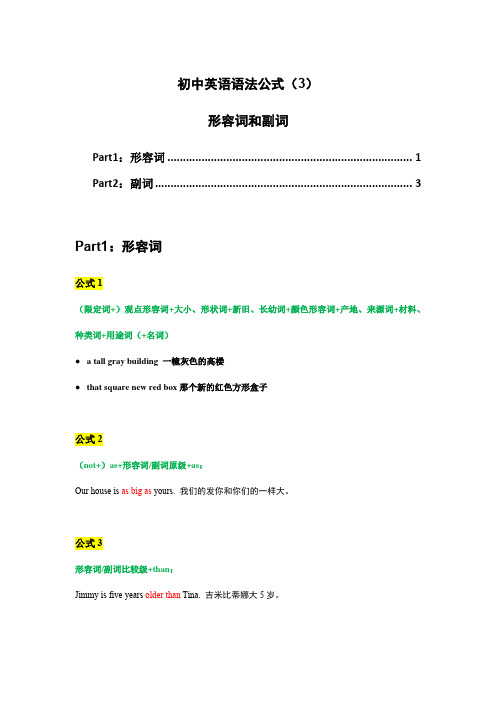
初中英语语法公式(3)形容词和副词Part1:形容词 (1)Part2:副词 (3)Part1:形容词公式1(限定词+)观点形容词+大小、形状词+新旧、长幼词+颜色形容词+产地、来源词+材料、种类词+用途词(+名词)● a tall gray building 一幢灰色的高楼●that square new red box那个新的红色方形盒子公式2(not+)as+形容词/副词原级+as:Our house is as big as yours. 我们的发你和你们的一样大。
公式3形容词/副词比较级+than:Jimmy is five years older than Tina. 吉米比蒂娜大5岁。
公式4形容词/副词比较级+and+形容词/副词比较级“越来越……”We are getting on better and better with one another. 我们之间相处的越来越融洽。
公式5the+形容词比较级,the+形容词比较级“越……,就越……”The more friends you have, the happier you will be. 你朋友越多,你就越开心。
公式6the+形容词/副词最高级+表示比较范围的短语/从句“是……中最……的”I like spring (the) best of the four seasons. 在四季中,我最喜欢春天。
公式7one of the+形容词最高级+可数名词复数+表示范围的短语/从句“是……中最……之一”One of the hardest language in the world is English. 世界上最难得语言之一就是英语。
公式8名词+形容词短语,形容词短语作定语时需后置。
●Australia is a country famous for its beautiful scenery.澳大利亚是一个以风景秀丽闻名的国家。
初中英语语法系列-形容词副词

elder eldest
older
older oldest
不规则形容词的比较级和最高级 good/well bad/ill little many/much far old
one those that 代替可数名词复数
比较时,为避免重复,可用哪些词代替? 有什么规律? 比较范围中的“包括”与“不包括”指的是什么?
代替可数名词单数
Li Lei is cleverer than any student in America Li Lei is cleverer than any other student In his class.
He is the shortest of the three.
English is one of the most important subjects.
.
中国是世界上第一大国。 上海是中国最大的城市。 他是三者当中最矮的。 英语是最重要的学科之一。
01
高老师是最受欢迎的教师之一。
more and more popular
the taller
the second longest
that
5.足球越来越受欢迎了. Football is _____________. 5.李梅是两个当中更高的女孩. Li Mei is ________ of the two girls 6.黄河是中国第二长河. Honghe River is______________ in China. 7.重庆的天气比北京的天气更热. The weather in Chingqing is hotter than _______ in Beijing.
副词一般在句中作状语. 副词作状语修饰动词一般 后置,修饰形容词或副词要前置.如:
初中英语语法与词汇(形容词,副词)
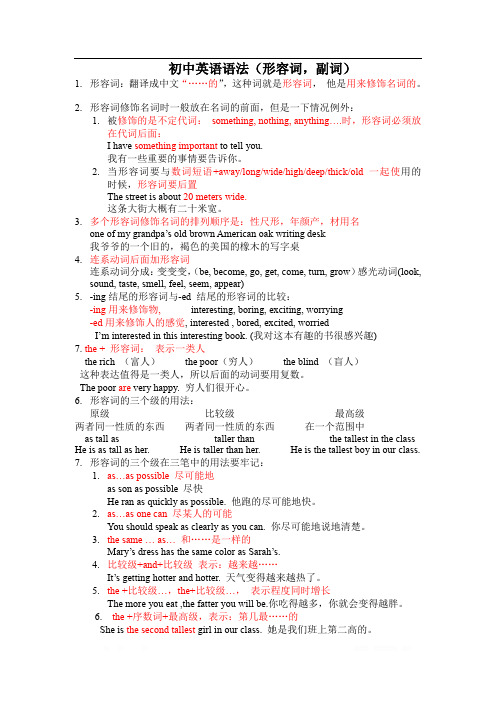
初中英语语法(形容词,副词)1.形容词:翻译成中文“……的”,这种词就是形容词,他是用来修饰名词的。
2.形容词修饰名词时一般放在名词的前面,但是一下情况例外:1.被修饰的是不定代词:something, nothing, anything….时,形容词必须放在代词后面:I have something important to tell you.我有一些重要的事情要告诉你。
2.当形容词要与数词短语+away/long/wide/high/deep/thick/old 一起使用的时候,形容词要后置The street is about 20 meters wide.这条大街大概有二十米宽。
3.多个形容词修饰名词的排列顺序是:性尺形,年颜产,材用名one of my grandpa’s old brown American oak writing desk我爷爷的一个旧的,褐色的美国的橡木的写字桌4.连系动词后面加形容词连系动词分成:变变变,(be, become, go, get, come, turn, grow)感光动词(look, sound, taste, smell, feel, seem, appear)5.-ing结尾的形容词与-ed 结尾的形容词的比较:-ing用来修饰物,interesting, boring, exciting, worrying-ed用来修饰人的感觉, interested , bored, excited, worriedI’m interested in this interesting book. (我对这本有趣的书很感兴趣)7. the + 形容词:表示一类人the rich (富人)the poor(穷人)the blind (盲人)这种表达值得是一类人,所以后面的动词要用复数。
The poor are very happy. 穷人们很开心。
6.形容词的三个级的用法:原级比较级最高级两者同一性质的东西两者同一性质的东西在一个范围中as tall as taller than the tallest in the class He is as tall as her. He is taller than her. He is the tallest boy in our class.7.形容词的三个级在三笔中的用法要牢记:1.as…as possible 尽可能地as son as possible 尽快He ran as quickly as possible. 他跑的尽可能地快。
初中英语语法——形容词副词
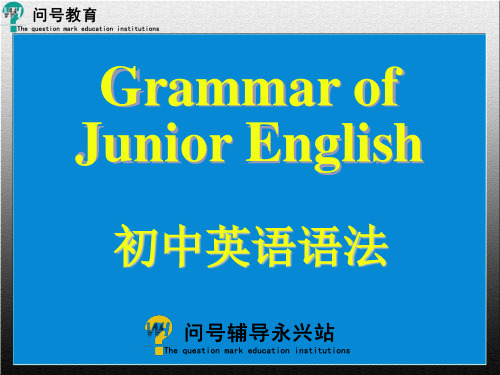
A living language should be learned orally(口头上). (活的语言应该从口头上学)(被动句) We have a living hope that you will succeed. (我们强烈地希望你能成功) Is she still alive? (她还活着吗?) They are the happiest children alive. (他们是活着的最开心的孩子)
⒀ gone、lost与missing
gone表示“丢了,没了”,含一去不复返 的意思,也可以表示“死了”,作表语或 宾补,不可以作定语; lost表示“丢失”,含难以找回的意思, 可作定语、表语或宾补; missing表示“失踪了,不见了”,强调 某人物不在原处,可作定语、表语或宾补。
My fever(高烧) is gone, but I still have a cough. (发烧消退了,但我仍然咳嗽) The parents found the lost child at last. (家长终于找到了迷路的孩子) My dictionary is missing.Who’s taken it away? (我的字典不见了,谁拿走了?) For more detailed information(详情) of the missing girls, please visit our website(网址). (如果想知道失踪女孩们的 详情,请访问我们的网站)
⑿ special与especial
表示事件不同寻常、过分或特殊时,两个词可 互换,但special较为常用。另外,special还可 以表示特别的目的。 She pays (e)special attention to clothes. (她非常注重着装) These are special chairs for small children. (这些是专门给小孩子的椅子)
最全初中英语语法之形容词副词教
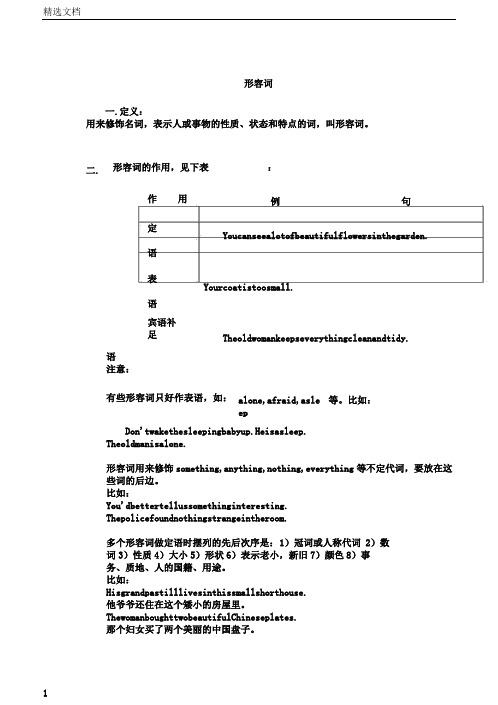
形容词一.定义:用来修饰名词,表示人或事物的性质、状态和特点的词,叫形容词。
二.形容词的作用,见下表:作用例句定Youcanseealotofbeautifulflowersinthegarden.语表Yourcoatistoosmall.语宾语补足Theoldwomankeepseverythingcleanandtidy.语注意:有些形容词只好作表语,如:alone,afraid,asle等。
比如:epDon'twakethesleepingbabyup.Heisasleep.Theoldmanisalone.形容词用来修饰something,anything,nothing,everything等不定代词,要放在这些词的后边。
比如:You'dbettertellussomethinginteresting.Thepolicefoundnothingstrangeintheroom.多个形容词做定语时摆列的先后次序是:1)冠词或人称代词 2)数词3)性质4)大小5)形状6)表示老小,新旧7)颜色8)事务、质地、人的国籍、用途。
比如:Hisgrandpastilllivesinthissmallshorthouse.他爷爷还住在这个矮小的房屋里。
ThewomanboughttwobeautifulChineseplates.那个妇女买了两个美丽的中国盘子。
形容词名词化:有些形容词前加定冠词后变为名词,表示一类人,谓语常用复数。
这种词有:rich/poor;good/bad;young/old;healthy/ill;living/dead;black/white(表示人种等)。
比如:Theyoungshouldtakegoodcareoftheold.年青人应当好好照料老人。
Therichneverhelpthepoorinthiscountry.在这个国家,富人素来不帮助穷人。
初中英语语法大全——形容词和副词
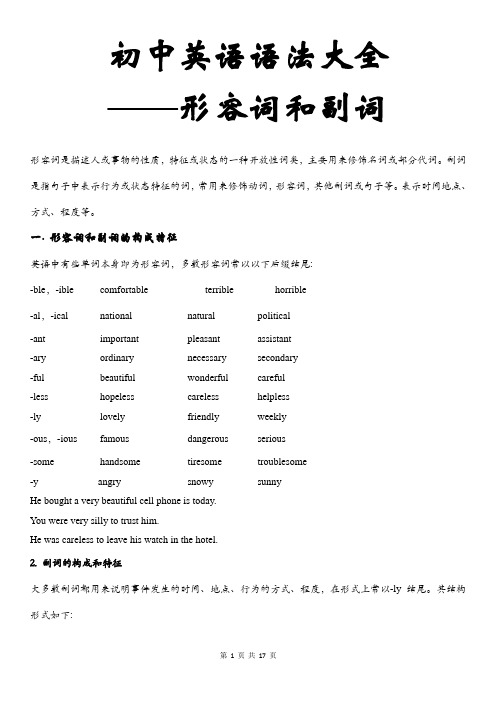
初中英语语法大全——形容词和副词形容词是描述人或事物的性质,特征或状态的一种开放性词类,主要用来修饰名词或部分代词。
副词是指句子中表示行为或状态特征的词,常用来修饰动词,形容词,其他副词或句子等。
表示时间地点、方式、程度等。
一. 形容词和副词的构成特征英语中有些单词本身即为形容词,多数形容词常以以下后缀结尾:-ble,-ible comfortable terrible horrible-al,-ical national natural political-ant important pleasant assistant-ary ordinary necessary secondary-ful beautiful wonderful careful-less hopeless careless helpless-ly lovely friendly weekly-ous,-ious famous dangerous serious-some handsome tiresome troublesome-y angry snowy sunnyHe bought a very beautiful cell phone is today.You were very silly to trust him.He was careless to leave his watch in the hotel.2. 副词的构成和特征大多数副词都用来说明事件发生的时间、地点、行为的方式、程度,在形式上常以-ly结尾。
其结构形式如下:The detective carefully observed everything in the room.He will completely finish his work by the end of this month.Such things will easily happen.二. 形容词和副词的种类1. 形容词的种类(1) 根据其结构形式分类,形容词可以分为简单形容词和合成形容词两类。
初中英语语法大全:形容词和副词汇总
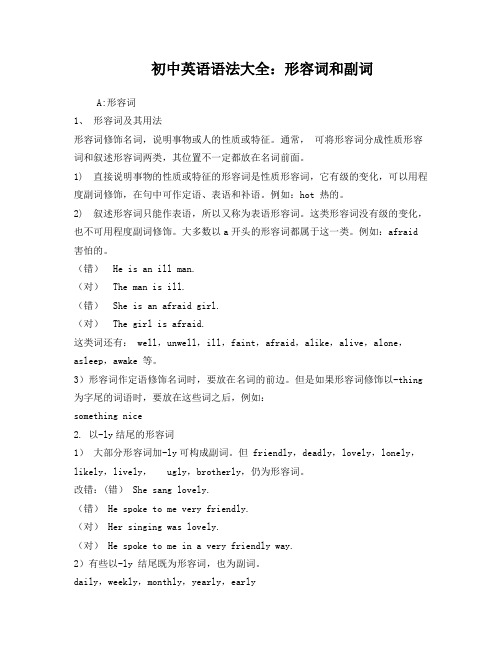
初中英语语法大全:形容词和副词A:形容词1、形容词及其用法形容词修饰名词,说明事物或人的性质或特征。
通常,可将形容词分成性质形容词和叙述形容词两类,其位置不一定都放在名词前面。
1) 直接说明事物的性质或特征的形容词是性质形容词,它有级的变化,可以用程度副词修饰,在句中可作定语、表语和补语。
例如:hot 热的。
2) 叙述形容词只能作表语,所以又称为表语形容词。
这类形容词没有级的变化,也不可用程度副词修饰。
大多数以a开头的形容词都属于这一类。
例如:afraid 害怕的。
(错)He is an ill man.(对)The man is ill.(错)She is an afraid girl.(对)The girl is afraid.这类词还有: well,unwell,ill,faint,afraid,alike,alive,alone,asleep,awake 等。
3)形容词作定语修饰名词时,要放在名词的前边。
但是如果形容词修饰以-thing 为字尾的词语时,要放在这些词之后,例如:something nice2. 以-ly结尾的形容词1)大部分形容词加-ly可构成副词。
但 friendly,deadly,lovely,lonely,likely,lively, ugly,brotherly,仍为形容词。
改错:(错) She sang lovely.(错) He spoke to me very friendly.(对) Her singing was lovely.(对) He spoke to me in a very friendly way.2)有些以-ly 结尾既为形容词,也为副词。
daily,weekly,monthly,yearly,earlyThe Times is a daily paper.The Times is published daily.3 用形容词表示类别和整体1)某些形容词加上定冠词可以泛指一类人,与谓语动词的复数连接。
初中英语语法形容词与副词
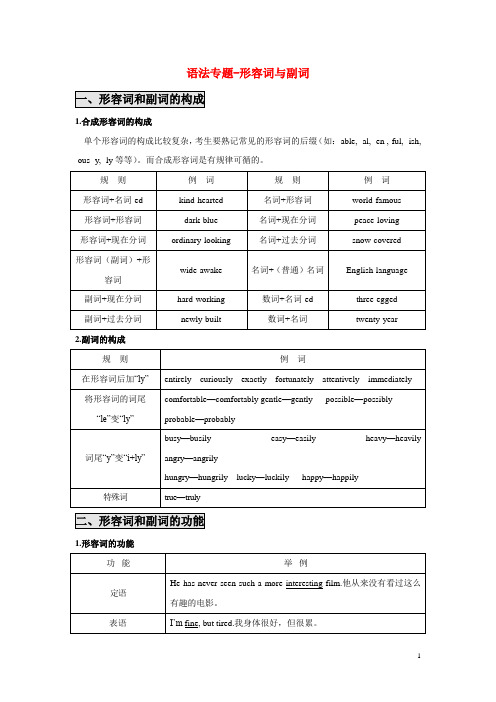
语法专题-形容词与副词一、形容词和副词的构成1.合成形容词的构成单个形容词的构成比较复杂,考生要熟记常见的形容词的后缀(如:-able, -al, -en ,-ful, -ish, -ous -y, -ly等等)。
而合成形容词是有规律可循的。
规则例词规则例词形容词+名词-ed kind-hearted 名词+形容词world-famous 形容词+形容词dark-blue 名词+现在分词peace-loving形容词+现在分词ordinary-looking 名词+过去分词snow-covered形容词(副词)+形容词wide-awake 名词+(普通)名词English-language 副词+现在分词hard-working 数词+名词-ed three-egged 副词+过去分词newly-built 数词+名词twenty-year2.副词的构成规则例词在形容词后加―ly‖entirely curiously exactly fortunately attentively immediately将形容词的词尾―le‖变―ly‖comfortable—comfortably gentle—gently possible—possibly probable—probably词尾―y‖变―i+ly‖busy—busily easy—easily heavy—heavily angry—angrilyhungry—hungrily lucky—luckily happy—happily特殊词true—truly二、形容词和副词的功能1.形容词的功能功能举例定语He has never seen such a more interesting film.他从来没有看过这么有趣的电影。
表语I’m fine, but tired.我身体很好,但很累。
★(1)连系动词+adj. 连系动词:①be动词②感官动词(look; smell; feel; touch; taste; sound)③“变化”型:(become; turn; go; get…)④―保持‖型:(keep /remain/stay…)★(2)It’s+adj.+(for/of sb.)+to do sth. ★(3)so+adj.+that句子“如此…以至…”★(4)too+adj.+to do sth.★(5)形容词/副词+enough The weather i s getti ng warmer and warmer.天气变得越来越暖和。
- 1、下载文档前请自行甄别文档内容的完整性,平台不提供额外的编辑、内容补充、找答案等附加服务。
- 2、"仅部分预览"的文档,不可在线预览部分如存在完整性等问题,可反馈申请退款(可完整预览的文档不适用该条件!)。
- 3、如文档侵犯您的权益,请联系客服反馈,我们会尽快为您处理(人工客服工作时间:9:00-18:30)。
形容词和副词一、形容词wheel(一个黄色的大木轮)⑵作表语时放在连系动词之后。
如:The price sounds reasonable.(这个价格听起来算是合理)⑶作宾语补足语时放在宾语之后。
如:We must try our best to keep our environment clean.(我们必须尽力保持我们的环境清洁)⑷后置的情况:①修饰复合不定代词时放在代词之后。
如:Something serious has happened to him.(他发生了严重的事故)②与表示“长、宽、高、重、老、远离”的词连用时形容词后置。
如:He‘s 1.8 metres tall.(他身高1.8米。
)The moon is about 380,000 kilometres away from the earth.(月球离地38万公里) 2) 、多个形容词修饰同一个名词的顺序:1.时间副词:一般放在句首或句尾,注意,early、late、before、later、yet等一般放在句尾,already、just一般放在动词的前面。
如:We will visit the Great Wall tomorrow.(我们明天要去参观长城) / They have already been to the UK twice.(他们去过英王国两次) / Soon the lost boy found his way back home.(不久迷路的孩子找到了回家的路)2.地点副词:一般放在句尾,但here、there还可放在句首。
如:There you can see thousands of bikes running in all directions(方向).(在那里,你可以看到成千上万的自行车朝各个方向流动) / The frightened wolf ran away.(受到惊吓的狼逃开了)/ He walked out quietly and turned back soon.(他悄悄地走了出去,很快又返回)3.方式副词:一般放在行为动之后,suddenly可以放在句首、句尾或动词之前。
如:Old people can hardly walk as quickly as young people.(老年人几乎不可能走得和年轻人一样快) / Suddenly he saw a light in the dark cave(山洞).(突然,在黑黢黢的山洞里,他看见了一丝亮光)4.程度副词:修饰动词时,放在动词之前;修饰形容词或副词时,放在形容词或副词之前。
但注意,enough总是放在被修饰的形容词或动词的后面;only位置比较灵活,总是放在被修饰的词的前面。
如:I nearly forgot all about it if he did not tell me again.(如果他不再次告诉我,我几乎把那事全忘了) / It was so strange that I could hardly believe my ears.(它那么奇怪一直我都不能相信我的耳朵) / She got to the station early enough to catch the first bus.(她早早地赶到车站赶上了首班车)5.频度副词:一般放在be动词之后或者助动词与主要动词之间,但sometimes、often等还可以放在句首或句尾,usually可放在句首,once可放在句尾,twice、three times等一般放在句尾。
如:Sometimes I get up early.(我有时起得早)/ The workers usually have lunch at the factory.(工人们通常在厂里吃午饭) / Take this medicine twice a day.(这种药一天吃两次)6.疑问副词:用于对句子的状语进行提问,位置总是在句首。
如:When and where were you born?(你何时何地出生?)/ Why did little Edison sit on some eggs?(小爱迪生为什么要坐在鸡蛋上?)/ How do you do?(你好!)7.连接副词:用来引导主语从句、宾语从句和表语从句,在从句中作状语。
How I am going to kill the cat is still a question.(我打算怎样杀死那只猫还是个问题)/ That is why everyone is afraid of the tiger.(那就是人人都害怕老虎的原因) / He wondered how he could do it the next day.(他不知道第二天怎样做那事)8.关系副词:用来引导定语从句,在从句中作状语。
如:This is the place where Mr Zhang once lived.(这就是张先生曾经住过的地方)/ Please tell me the way how you have learned English so well.(请告诉我你的英语是怎样学得这么好的方法)9.其它副词:too“也”,用在句尾;also放在动词前;either ―也不‖,放在句尾;nor“也不”,放在句首;so“如此,这样”,放在形容词、副词前;on/off“开/关”放在动词之后;not放在be之后、助动词之后、不定式或动名词之前;maybe/perhaps放在句首;certainly放在句首或动词之前。
如:He went to the Palace Museum and I went there,too.(他去了故宫博物院,我也去了) / Maybe your ticket is in your inside pocket.(也许你的票就在你的里边衣袋里) / --Tom doesn‘t have a comp uter. –Nor do I.(汤姆没有计算机,我也没有。
),放在be等连系动词之后,说明人物所处的位置。
如:I‘m very sorry he isn‘t in at the moment.(很抱歉,他此刻不在家)/ I have been away from my hometown for 我离开家乡有将近20年了) / Jim is over there.(吉姆就在那边)、then)以及许多地点副词都可以作名词的定语,放在名词的后面。
如:People now often have their festival dinners at restaurants.(现在的人们经常在餐馆里吃节日晚宴) /Women there were living a terrible life in the 1920s.(在二十世纪20年代那儿的女人过着可怕的Put your dirty socks away, Jim! They are giving out bad smell!(吉姆,把你的脏袜子拿开!它们在散发着臭气。
) / Father kept him in and doing his lessons.(父亲把他关在家里做作业)[注意] “动词+副词”的宾语如果是代词,则该副词应该放在代词之后。
如:He wrote down the word.(他写下了那个词。
)→He wrote it down.(他把它写了下来。
)==形容词变副词的规律a.一般的形容词在结尾加ly变为副词。
例如:careful-carefullyb.以元音加e结尾的单词要去e在加ly。
例如:true-trulyc.辅音加y结尾的单词去y变i在加ly。
例如:angry-angrilyd.单音节y结尾直接加ly。
例如:shy-shylye.以le结尾的单词直接将e变为y。
例如:terrible-terriblyf.形容词、副词同形:hard, fast, friendly, late, early, lovely, long。
这部分请同学们注意,其中很多单词加ly之后就变成其他意思的单词了。
例如:hardly就变成“几乎不”的意思,是小学阶段五大隐形否定词(few,little, never, seldom, hardly)之一。
三、形容词副词的原级、比较级和最高级,在原级的后面加上er,est构成比较级和最高级。
a)直接加er,est :b)以重读闭音节结尾的,要双写最后一个辅音字母,后加er,est:c)以辅音字母+y结尾的,先把y改为i再加上er,est:,在原级前加more / most.主语(sb./sth) + 谓语动词+ (very/too/so/quite/rather…) + 形容词/副词原级+….如:He is very old now.(他现在很老了) / They ran quite fast.(它们跑得相当快) / The weather looks rather bad.(天气看上去相当糟) / I am so happy!(我是如此的快乐)☆表示两者之间没有差别时,使用句型:主语(第一个人物) + 谓语动词+ as + 形容词/副词原级+ as + 第二个人物+….如:He is as excited as his younger sister.(他和他妹妹一样兴奋)/ Lily rode her bike as slowly as an old lady.(莉莉骑车像老太太一样慢)/ They picked as many apples as the farmers (did).(他们摘的苹果和农民一样多)☆表示第一个人比不上第二个人时,使用句型:主语(第一个人物) + 谓语动词(否定式)+ as / so + 形容词/副词原级+ as + 第二个人物+….如:He isnot so / as excited as his younger sister.(他没他妹妹那么兴奋) / Lily did not ride her bike so / as slowly as an old lady. (莉莉骑车不像老太太那样慢) / They didn‘t pick so / as many apples as the farmers (did). (他们摘的苹果不如农民多)(2) 讲述两者有差异,第一个人物超过第二个人物时,用比较级。
基本句型:主语(‘A’)+谓语动词+(much/a little/even/still)+形容词/副词比较级+than+第二个人物(‘B’)+….如:A modern train is much faster than a car.(现代的火车比轿车快多了) / This book didn‘t cost me more than that one.(这本书花费我的钱不比那本多)讲述两者有差异,第一个人物不及第二个人物时,用比较级。
